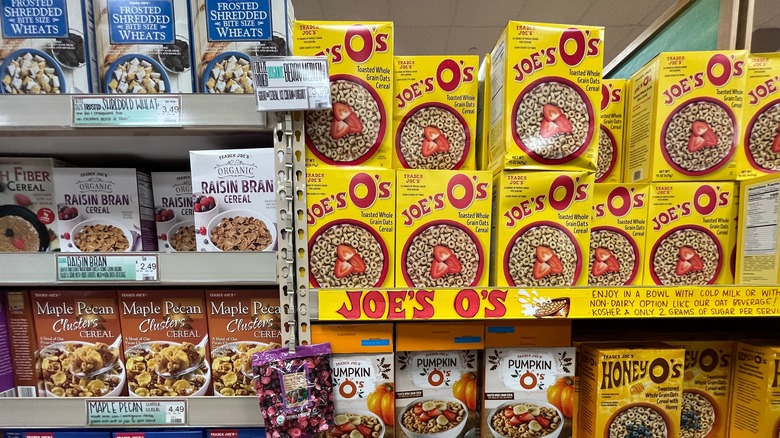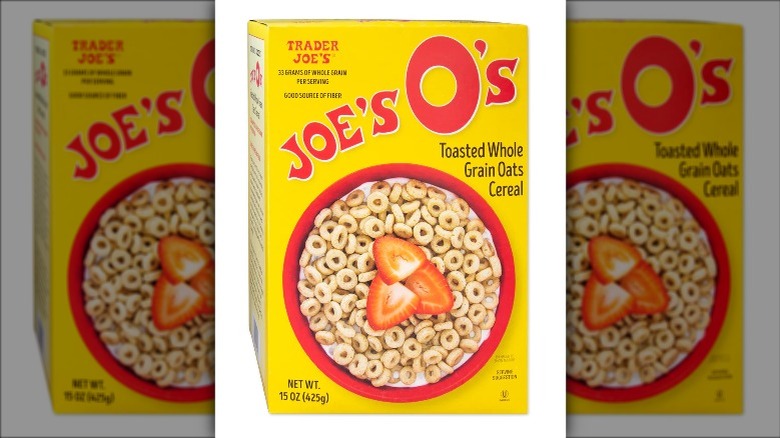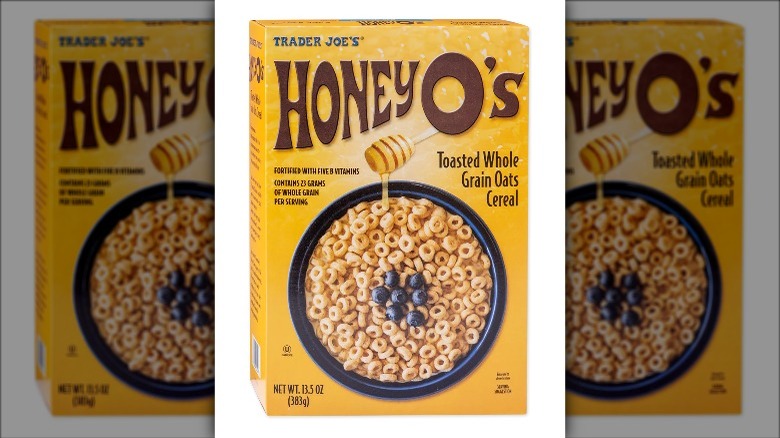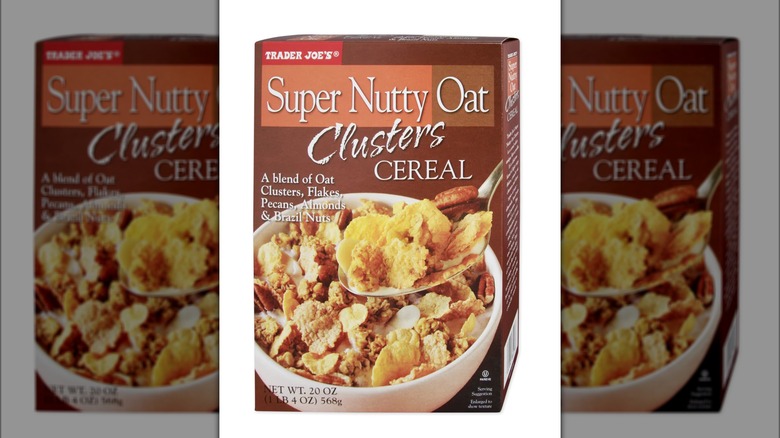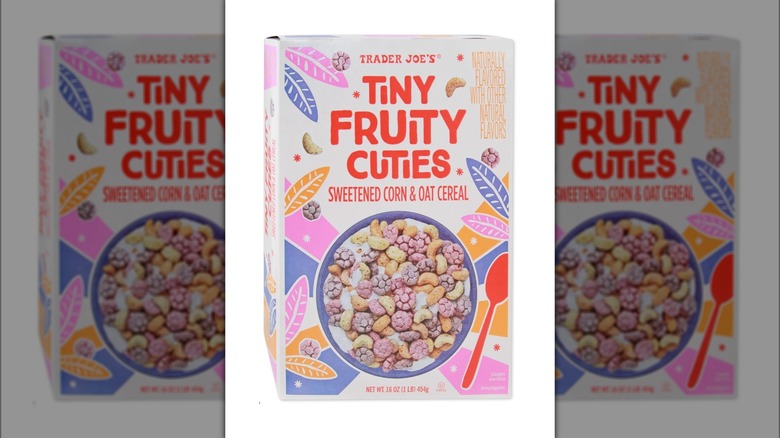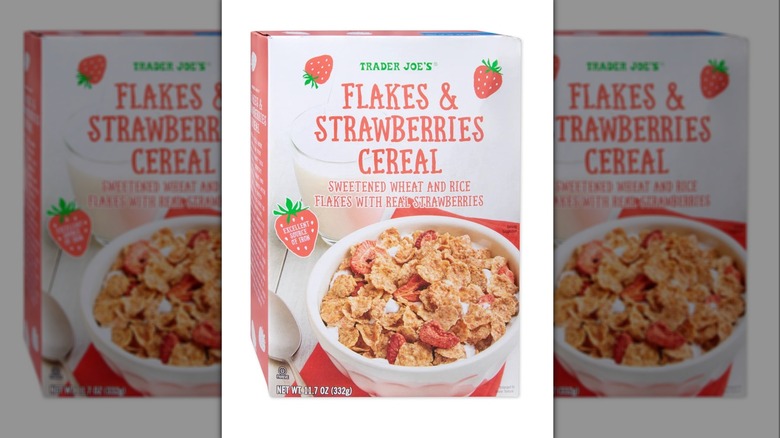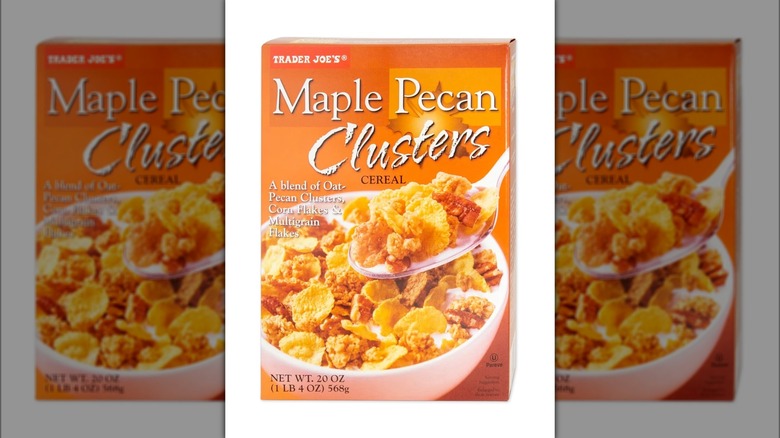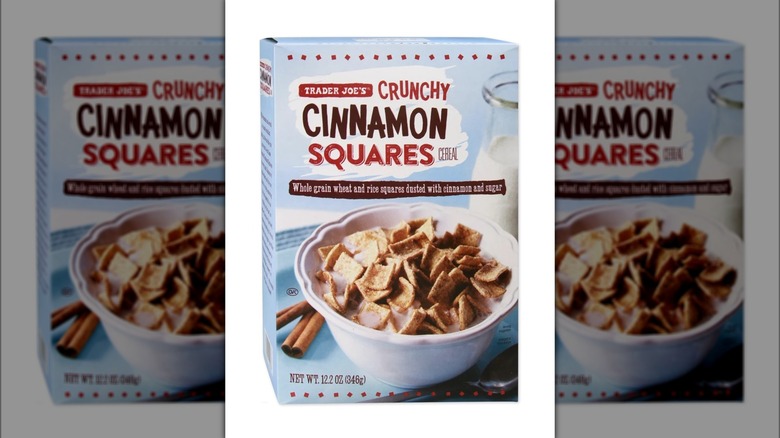7 Trader Joe's Cereals And Their Name-Brand Equivalents
Though the products in the Trader Joe's breakfast cereal aisle don't typically win any TJ's popularity contests, they remain a go-to staple for the average shopper. Anyone who's snagged a box of Super Nutty Oat Clusters or Crunchy Cinnamon Squares has likely noticed more than a few similarities between the chain's brands and those found at your local supermarket. But which brand should be lining the top shelf of your pantry?
It's a complicated question that many have had to consider lately. On the one hand, all that aggressive marketing toward consumers when they're young has made people strangely loyal to their preferred cereal brand. On the other hand, recent skyrockets in grocery store prices have seen brand loyalty take a hit. Despite the collective urge to go cuckoo for Cocoa Puffs or steal a bit of Lucky the Leprechaun's Lucky Charms, cereal prices just aren't very grrreat at the moment, and longtime fans have taken notice.
As the winds of change seem to be blowing down the breakfast aisle, perhaps it's time to crunch some numbers and crunch some Joe's O's. Here's a rundown of a few popular Trader Joe's cereals and a side-by-side comparison with their name-brand counterparts.
1. Joe's O's vs. Cheerios
The O-riginal gangsta of Trader Joe's-brand cereals, Joe's O's are the backbone of any TJ's breakfast lineup. These donut-shaped hoops of toasted whole grain oats are most reminiscent of General Mills' Cheerios. This duo is perhaps the most evenly matched pair on the list — there's almost a tit-for-tat comparison when it comes to flavor and nutritional value.
From a texture perspective, Joe's O's are a bit on the heartier side — there's less give to the crunch, whereas Cheerios are lighter, crispier, and more prone to making you chase them around the surface of the leftover milk in your bowl. One is not necessarily better than the other in this department, so it all comes down to personal preference.
Even from a nutritional standpoint, the cereals are neck and neck as far as calories, sodium, and net carbs per serving. Cheerios does offer a bit more in the way of calcium, iron, potassium, and folic acid, but those numbers are matched by Joe's O's increased servings of thiamin, niacin, vitamin B6, and zinc. Nutritionally, these two are basically dead even.
The area where Joe's O's handily has Cheerios on the ropes is the price. A 15-ounce box of Joe's O's is $2.49 as of this writing, while an 8.9-ounce box of Cheerios retails for over $1 more at $3.68. Considering that 15 ounces of Cheerios would be nearly double the price of Joe's O's, it's safe to say that TJ's takes the win in the price category.
2. Honey O's vs. Honey Nut Cheerios
Just like Cheerios has a sweeter, more kid-friendly cousin called Honey Nut Cheerios, Joe's O's has a honey-tinged version appropriately named Honey O's. Like Joe's O's, Honey O's have a bit more textural heft with each spoonful. The honey flavor here is also a bit more subtle than Honey Nut Cheerios', which can get a bit cloying, so Honey O's may have Honey Nut Cheerios beat on flavor and texture.
Most of Honey Nut Cheerios' marketing is based around how "heart-healthy" it is — when a cartoon bee says it on TV, it must be true, right? A side-by-side comparison only marginally favors Honey Nut Cheerios where the good stuff is concerned, however.
The heart-healthy aspect of Honey Nut Cheerios is its dietary fiber content. On paper, getting 10% of your daily fiber intake per serving of Honey Nut Cheerios is great, but strolling just a few rows down on the nutrition facts chart reveals a 12-gram hit of sugar for every 35 grams of Honey Nut Cheerios you eat, and this ratio is about the same for Honey O's. The effects of the added sugar offset the health benefits of dietary fiber, which means either of these options is fine for indulging your sweet tooth but not necessarily strengthening your ticker.
Trader Joe's once again beats out the big brands price-wise, as a 13.5-ounce box of Honey O's costs $2.69, compared to a 10.8-ounce box of Honey Nut Cheerios clocking in at $3.68. Honey O's and Honey Nut Cheerios are a bit more closely matched, but there's a bit of an ick factor to the latter's heart-healthy messaging.
3. Super Nutty Oat Clusters vs. Honey Bunches of Oats
The Super Nutty Oat Clusters from Trader Joe's include the holy trinity of flavor, texture, and versatility all in one package. Their supermarket counterpart is Post's Honey Bunches of Oats, and the two are neck and neck when it comes to comparison. While the $4.79 price point for a 20-ounce box of Super Nutty Oat Clusters is slightly cheaper than $4.93 for an 18-ounce box of Honey Bunches of Oats, it's not as great a margin as other cereals.
Since the price point doesn't automatically give TJ's a win here, let's take it to the bowl. Super Nutty Oat Clusters are quite similar to eating a bowl of granola instead of cereal. Like Joe's O's, this particular cereal is heartier than its Post counterpart, and it would stand up a bit better when tossed into a homemade trail mix or as a crunchy layer in a yogurt parfait. That said, the additional flakes in Honey Bunches of Oats make for a lighter, crispier breakfast adventure.
Nutritionally, you're getting a bit more fiber from Super Nutty Oat Clusters, and the cereals offer a close margin of total carbs — Super Nutty has 41 grams per serving, and Honey Bunches has 42 grams. Surprisingly, Honey Bunches of Oats has a ton of iron, niacin, vitamin B6, folic acid, and vitamin B12, making it slightly more vitamin-heavy than its TJ's counterpart. It's a tough call, but it's looking like Honey Bunches of Oats takes the win in this matchup.
4. Tiny Fruity Cuties vs. Trix
While plenty of the Trader Joe's options on this list seem to cater to adult shoppers, TJ's hasn't completely lost its inner child when it comes to breakfast cereal. Tiny Fruity Cuties, for example, come in cute little fruity shapes that are packed with big fruity flavors. This cereal's appearance and flavor profile make its closest supermarket counterpart Trix from General Mills.
Going into this battle, Tiny Fruity Cuties might have the edge for a few reasons. They're about $1 cheaper per 16-ounce box than their supermarket cousin, and they're great for shoppers who are trying to avoid artificial flavors or colors. All the vibrant color and citrusy flavor found in a box of Tiny Fruity Cuties comes from ingredients like vegetable juice, annatto extract, and natural flavors, which is a bit of a rarity on today's grocery shelves. Trix, on the other hand, uses both artificial flavors and colors to get its myriad hues, which can be a turnoff for the more discerning shopper.
Both cereals have a decent variety of vitamins and minerals included, though a side-by-side comparison shows that Tiny Fruity Cuties have a bit more calcium, iron, and potassium per serving than Trix. The latter does have more vitamins A, C, and D, however, so it's a bit of a toss-up as far as this category goes.
5. Flakes & Strawberries vs. Special K Red Berries
Freeze-dried strawberries are an excellent addition to any breakfast cereal, and Trader Joe's Flakes & Strawberries saves you the trouble of finding your own. Flakes & Strawberries take advantage of this crisped up fruit to add some sweetness, tartness, and an interesting texture to every bite. The closest approximation when it comes to a supermarket version would have to be Special K Red Berries from Kellogg's.
This is one of the closer matchups as far as flavor and texture, as the cereals' whole grain wheat and rice flakes have the same light, crisp crunch. As delightful as they are, freeze-dried strawberries are freeze-dried strawberries, so the flavor profile is pretty similar there, as well. Both cereals offer a decent daily percentage of vitamins and minerals, with Special K bringing more dietary fiber, iron, and folic acid to the table. As Flakes & Strawberries has Special K beat on price — an 11.7-ounce box of the former runs $2.99, whereas the same size box of the latter is $3.98 — it might be time for Special K fans to trade up.
6. Maple Pecan Clusters vs. Honey Bunches of Oats Maple & Pecans
Maple Pecan Clusters are an autumnal variation of Trader Joe's Super Nutty Oat Clusters, and they bring the classic combo of maple syrup and pecans to your bowl. This cereal's closest supermarket contender is Honey Bunches of Oats Maple & Pecans from Post. While the basic versions of both cereals were a pretty close comparison, the results from this matchup may not be as neck-and-neck. For starters, TJ's Maple Pecan Clusters beat the Post version handily on price — it's significantly more expensive to get the maple-pecan Honey Bunches of Oats.
Artificial maple flavoring in anything outside of tabletop maple syrup runs the risk of tasting too artificial. As Post lists artificial flavors among Honey Bunches of Oats Maple & Pecans' ingredients but does not list maple syrup, logic would dictate that it's rolling with fake maple flavor, which just doesn't taste as good as the real deal. Maple Pecan Clusters use maple syrup, and it definitely makes a difference. Like Super Nutty Oat Clusters, Maple Pecan Clusters are a bit more like maple granola, so you've got a bit of hearty versatility there that Honey Bunches of Oats Maple & Pecans just doesn't have.
7. Crunchy Cinnamon Squares vs. Cinnamon Toast Crunch
Both TJ's Crunchy Cinnamon Squares and their General Mills counterpart Cinnamon Toast Crunch are top-tier breakfast cereal selections. Few cereals are as pleasing for adults as they are for children — their flavors are on point, they're texturally unbeatable when you get a stack of them between your molars and bite down, and they leave your milk tasting like horchata.
It's hard to sidestep the nostalgia factor when it comes to Cinnamon Toast Crunch, but the Crunchy Cinnamon Squares have done a great job of carving out their own breakfast cereal niche. With every comparison on this list, Trader Joe's has tended to go for a heartier texture, but that's not the case with Crunchy Cinnamon Squares. They're light and almost wafer-like — definitely airier than Cinnamon Toast Crunch. The superiority of one over the other is definitely up for consumer discussion.
As far as price goes, a 12-ounce box of Cinnamon Toast Crunch is only around 50 cents more than a 12.2-ounce box of Crunchy Cinnamon Squares — not a terrible margin to base one's flavor preference around. Neither cereal is ideal for a low-carb diet — they both pack around 30 grams of net carbs per serving — but those who prefer a greater proportion of cane sugar than fructose in their cereal will want to stick with the TJ's version.
The fascinating aspect of these comparisons is that Trader Joe's cereals are all really good, even if you grew up on the big brand names. For the price difference you're getting on most of these options, it's starting to make more sense to abandon the big brands and head on over to Trader Joe's.
